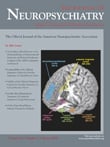A 27-year-old man was admitted to our hospital because of depressed mood, severe insomnia, and suicidal ideations. Since early childhood the patient showed poor speech and language and symptoms of psychomotor and intellectual slowing. He finished secondary school at the age of 17 (usually 15–16 years) and was then employed in simple jobs. He suffered from auditory hallucinations, delusions, and illusionary misinterpretations for about 4 years. A first episode of catatonic stupor with waxy flexibility and catalepsy occurred 1 month prior to admission and further episodes were observed during his stay in our clinic, each of them associated with extreme anxiety and motor anosognosia. There was no indication of a head trauma, meningitis, or encephalitis in the patient’s medical history.
We observed a patient with impaired speech initiation, slowness and poverty of speech, verbal perseverations, and difficulties with the grammar but preserved language comprehension. Interestingly, the patient spoke only to very few individuals in the hospital who became familiar to him and trustworthy, which is consistent with a selective mutism, a behavioral trait reported to have existed since his first schooldays. However, his nonverbal social behavior was normal and there was no indication for symptoms of the autistic spectrum disorder. During his psychotic episode, our patient had even less drive than before, his motion was markedly slowed down and he was unable to recognize his personal situation; he was totally unconcerned in this respect. He was also indifferent to consequences of important decisions he made. Routine laboratory parameter testing, including drug screening, was normal, as were physical status and neurological examination. EEG, MRI, and [
18 F]fluorodeoxyglucose positron emission tomography (FDG-PET) did not show any brain abnormalities. Cognitive functions were first assessed 10 weeks after admission when acute psychosis, catatonia, and depressive mood had remitted, and 19 weeks later with standardized neuropsychological testing procedures.
2 Medication consisted of risperidone (8 mg/day) and venlafaxine (300 mg/day). Cognitive performance was severely impaired in visual processing speed, alertness, selective and divided attention, verbal and visual working memory, verbal learning, and word fluency. In contrast, concept formation and reasoning were normal. The neuropsychological deficit pattern was similar 19 weeks later indicating that cognitive deficits were state- and not trait-dependent. Consistently, subscales (especially anergia) of the Brief Psychiatric Rating Scale (BPRS)
3 that cover motivation and initiation did not change over this period but were still the most affected items even 29 weeks after admission. In contrast, scores in the subscale for anxiety/depression of the BPRS (18 points) and in the Hamilton Depression Rating Scale (HAM-D) (30 points)
4 were clearly pathological at admission. These scores continuously dropped and remained stable ongoing from week 10 (BRPS=4–5; HAM-D=2–4 points).

